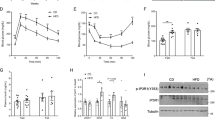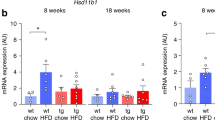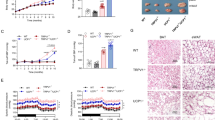Abstract
Objective:
We have previously demonstrated that 1α, 25(OH)2D3 promotes adipocyte reactive oxygen species (ROS) production. We have now evaluated whether decreasing 1α, 25(OH)2D3 levels by increasing dietary calcium will decrease oxidative stress in vivo.
Methods:
We fed low-calcium (0.4% Ca) and high-calcium (1.2% Ca from CaCO3) obesity-promoting (high sucrose/high fat) diets to aP2-agouti transgenic mice and assessed regulation of ROS production in adipose tissue and skeletal muscle.
Results:
Mice on the high-calcium diet gained 50% of the body weight (P=0.04) and fat (P<0.001) as mice on the low-calcium diet (0.4% Ca). The high-calcium diet significantly reduced adipose intracellular ROS production by 64 and 18% (P<0.001) and inhibited adipose tissue nicotinamide adenine dinucleotide phosphate oxidase expression by 49% (P=0.012) and 63% (P=0.05) in visceral and subcutaneous adipose tissue, respectively. Adipocyte intracellular calcium ([Ca2+]i) levels were suppressed in mice on the high-calcium diet by 73–80% (P<0.001). The high-calcium diet also induced 367 and 191% increases in adipose mitochondrial uncoupling protein 2 (UCP2) expression (P<0.001) in visceral and subcutaneous adipose tissue, respectively. The pattern of UCP3 expression and indices of ROS production in skeletal muscle were consistent with those in adipose tissue. The high-calcium diet also suppressed 11β-hydroxysteroid dehydrogenase (11β-HSD) expression in visceral adipose tissue by 39% (P=0.034). 11β-HSD expression was markedly higher in visceral vs subcutaneous adipose tissue in mice on the low-calcium diet (P=0.034), whereas no difference was observed between the fat depots in mice on the high-calcium diet.
Conclusion:
These data support a potential role for dietary calcium in the regulation of obesity-induced oxidative stress.
This is a preview of subscription content, access via your institution
Access options
Subscribe to this journal
Receive 12 print issues and online access
$259.00 per year
only $21.58 per issue
Buy this article
- Purchase on Springer Link
- Instant access to full article PDF
Prices may be subject to local taxes which are calculated during checkout








Similar content being viewed by others
References
Furukawa S, Fujita T, Shimabukuro M, Iwaki M, Yamada Y, Nakajima Y et al. Increased oxidative stress in obesity and its impact on metabolic syndrome. J Clin Invest 2004; 114: 1752–1761.
Atabek ME, Vatansev H, Erkul I . Oxidative stress in childhood obesity. J Pediatr Endocrinol Metab 2004; 17: 1063–1068.
Lin TK, Chen SD, Wang PW, Wei YH, Lee CF, Chen TL et al. Increased oxidative damage with altered antioxidative status in type 2 diabetic patients harboring the 16189 T to C variant of mitochondrial DNA. Ann NY Acad Sci 2005; 1042: 64–69.
Sonta T, Inoguchi T, Tsubouchi H, Sekiguchi N, Kobayashi K, Matsumoto S et al. Evidence for contribution of vascular NAD(P)H oxidase to increased oxidative stress in animal models of diabetes and obesity. Free Radic Biol Med 2004; 37: 115–123.
Inoguchi T, Li P, Umeda F, Yu HY, Kakimoto M, Imamura M, Aoki T et al. High glucose level and free fatty acid stimulate reactive oxygen species production through protein kinase C-dependent activation of NADPH oxidase in cultured vascular cells. Diabetes 2000; 49: 1939–1945.
Shangari N, O'Brien PJ . The cytotoxic mechanism of glyoxal involves oxidative stress. Biochem Pharmacol 2004; 68: 1433–1442.
Chung SS, Ho EC, Lam KS, Chung SK . Contribution of polyol pathway to diabetes-induced oxidative stress. J Am Soc Nephrol 2003; 14: S233–S236.
Zemel MB . Calcium and dairy modulation of obesity risk. Obes Res 2005; 13: 192–193.
Sun X, Zemel MB . Role of uncoupling protein 2 (UCP2) expression and 1alpha, 25-dihydroxyvitamin D3 in modulating adipocyte apoptosis. FASEB J 2004; 18: 1430–1432.
Shi H, Norman AW, Okamura WH, Sen A, Zemel MB . 1alpha, 25-Dihydroxyvitamin D3 modulates human adipocyte metabolism via nongenomic action. FASEB J 2001; 15: 2751–2753.
Shi H, Norman AW, Okamura WH, Sen A, Zemel MB . 1alpha, 25-dihydroxyvitamin D3 inhibits uncoupling protein 2 expression in human adipocytes. FASEB J 2002; 16: 1808–1810.
Sun XC, Morris K, Zemel MB . 1, 25(OH)2D3 and reactive oxygen species interatively stimulate angiotensinogen expression in differentiated 3T3-L1 adipocytes. FASEB J 2005; 19: A70 (abstract).
Zemel MB, Shi H, Greer B, Dirienzo D, Zemel PC . Regulation of adiposity by dietary calcium. FASEB J 2000; 14: 1132–1138.
Sun XC, Zemel MB . Calcium and dairy products inhibit weight and fat regain during ad libitum consumption following energy restriction in Ap2-agouti transgenic mice. J Nutr 2004; 134: 3054–3060.
Reeves PG . Components of the AIN-93 diets as improvements in the AIN-76A diet. J Nutr 1997; 127: 838S–841S.
Zemel MB . Effects of mitochondrial uncoupling on adipocyte intracellular Ca2+ and lipid metabolism. J Nutr Biochem 2003; 14: 219–226.
Manea A, Constantinescu E, Popov D, Raicu M . Changes in oxidative balance in rat pericytes exposed to diabetic conditions. J Cell Mol Med 2004; 8: 117–126.
Xue B, Zemel MB . Relationship between human adipose tissue agouti and fatty acid synthase (FAS). J Nutr 2000; 130: 2478–2481.
Xue B, Moustaid N, Wilkison WO, Zemel MB . The agouti gene product inhibits lipolysis in human adipocytes via a Ca2+-dependent mechanism. FASEB J 1998; 12: 1391–1396.
Zemel MB . Role of calcium and dairy products in energy partitioning and weight management. Am J Clin Nutr 2004; 79: 907S–912S.
Toescu EC . Hypoxia sensing and pathways of cytosolic Ca2+ increases. Cell Calcium 2004; 36: 187–199.
Ermak G, Davies KJ . Calcium and oxidative stress: from cell signaling to cell death. Mol Immunol 2002; 38: 713–721.
Miwa S, Brand MD . Mitochondrial matrix reactive oxygen species production is very sensitive to mild uncoupling. Biochem Soc Trans 2003; 31: 1300–1301.
Brookes PS . Mitochondrial H(+) leak and ROS generation: an odd couple. Free Radic Biol Med 2005; 38: 12–23.
Gordeeva AV, Zvyagilskaya RA, Labas YA . Cross-talk between reactive oxygen species and calcium in living cells. Biochemistry (Moscow) 2003; 68: 1077–1080.
Volk T, Hensel M, Kox WJ . Transient Ca2+ changes in endothelial cells induced by low doses of reactive oxygen species: role of hydrogen peroxide. Mol Cell Biochem 1997; 171: 11–21.
Brand MD, Buckingham JA, Esteves TC, Green K, Lambert AJ, Miwa S et al. Mitochondrial superoxide and aging: uncoupling-protein activity and superoxide production. Biochem Soc Symp 2004; 71: 203–213.
Korshunov SS, Skulachev VP, Starkov AA . High protonic potential actuates a mechanism of production of reactive oxygen species in mitochondria. FEBS Lett 1997; 416: 15–18.
Zemel MB, Richards J, Mathis S, Milstead A, Gebhardt L, Silva E . Dairy augmentation of total and central fat loss in obese subjects. Int J Obes Relat Metab Disord 2005; 29: 391–397.
Agarwal AK . Cortisol metabolism and visceral obesity: role of 11beta-hydroxysteroid dehydrogenase type I enzyme and reduced co-factor NADPH. Endocr Res 2003; 29: 411–418.
Morris KL, Zemel MB . 1,25-Dihydroxyvitamin D3 modulation of adipocyte glucocorticoid function. Obes Res 2005; 13: 670–677.
Acknowledgements
This research was supported by an unrestricted grant from The National Dairy Council.
Author information
Authors and Affiliations
Corresponding author
Rights and permissions
About this article
Cite this article
Sun, X., Zemel, M. Dietary calcium regulates ROS production in aP2-agouti transgenic mice on high-fat/high-sucrose diets. Int J Obes 30, 1341–1346 (2006). https://doi.org/10.1038/sj.ijo.0803294
Received:
Revised:
Accepted:
Published:
Issue Date:
DOI: https://doi.org/10.1038/sj.ijo.0803294
Keywords
This article is cited by
-
Effect of dietary calcium (Ca) on body composition and Ca metabolism during growth in genetically obese (β) male rats
European Journal of Nutrition (2013)
-
Low-fat dairy, but not whole-/high-fat dairy, consumption is related with higher serum adiponectin levels in apparently healthy adults
European Journal of Nutrition (2013)
-
A high calcium diet containing nonfat dry milk reduces weight gain and associated adipose tissue inflammation in diet-induced obese mice when compared to high calcium alone
Nutrition & Metabolism (2012)
-
Calcium and 1,25‐Dihydroxyvitamin D3 Regulation of Adipokine Expression
Obesity (2007)
-
1α,25‐Dihydroxyvitamin D3 Modulation of Adipocyte Reactive Oxygen Species Production
Obesity (2007)



